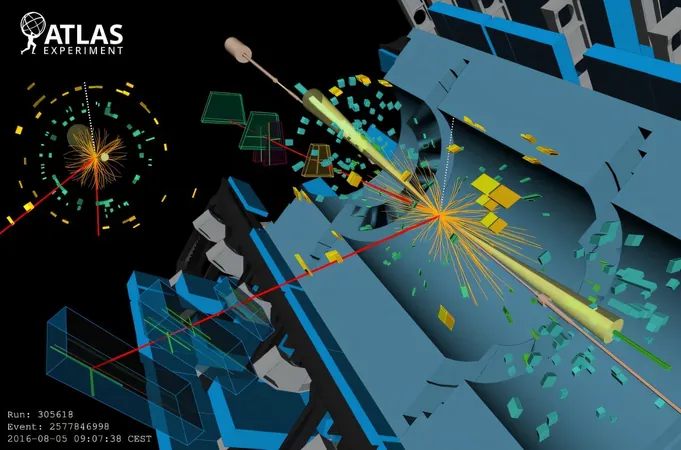
Unveiling the Secrets of the Higgs Mechanism: ATLAS Takes a Giant Leap
2025-04-14
Author: Ming
Revolutionizing Our Understanding of Particle Physics
The recent detection of longitudinally polarized W boson production at the Large Hadron Collider (LHC) marks a groundbreaking advancement in unraveling the Higgs mechanism—a pivotal enigma regulating how elementary particles obtain their masses.
A Historic Discovery in 2012
In 2012, the ATLAS and CMS collaborations at CERN made waves with the discovery of the Higgs boson, unlocking a wealth of knowledge about the cosmos. This remarkable finding pointed to an ancient and mysterious field that allows particles to gain their vital masses.
Electroweak Symmetry Breaking: The Puzzle Deepens
At the heart of this phenomenon is electroweak symmetry breaking, a concept proposed in 1964 that remains one of the least understood aspects of the Standard Model of particle physics. In its infancy, shortly after the Big Bang, the universe's interactions were thought to be unified. Yet, this symmetry broke, leading to the existence of massive W and Z bosons, while the photon remained massless.
A Breakthrough at Rencontres de Moriond Conference
Just last week, the ATLAS collaboration presented significant findings at the Rencontres de Moriond conference. Utilizing full datasets from the LHC's Run 2, collected between 2015 and 2018 at a staggering 13 TeV, the team revealed evidence for a crucial process involving the W boson.
The Quest for Confirmation of the BEH Mechanism
The Brout-Englert-Higgs (BEH) mechanism plays a vital role in this understanding, as the Higgs boson discovery has provided the first experimental validation of this intricate framework. Current investigations are underway to measure how strongly the Higgs particle interacts with others, seeking to confirm that the masses of fundamental matter particles stem from their interplay with the BEH field.
New Predictions and Future Investigations
The BEH mechanism also holds further predictions that need validation. Key measurements involve the interactions between longitudinally polarized W or Z bosons, as well as the Higgs boson's self-interaction. While the latter will likely require future collider experiments post-2030, preliminary studies of boson scattering are expected to unfold sooner.
The Physics of Longitudinal Polarization
Polarization in particles describes the orientation of their spin in space, with longitudinally polarized particles possessing their spin perpendicular to their momentum—something only achievable by massive particles. The existence of these longitudinal states of W and Z bosons is directly tied to the BEH mechanism, making their interactions a potent testing ground for understanding electroweak symmetry breaking.
Probing Longitudinally Polarized W Boson Interactions
Experimental probing of WL–WL interactions is conducted through vector–boson scattering (VBS), where quarks emit W bosons that subsequently interact, generating additional W or Z bosons. This intricate process will help physicists identify whether the current models underscore the simple BEH mechanism or hint at undiscovered physics beyond the Standard Model.
A Significant ATLAS Milestone Achieved
The latest ATLAS analysis focuses on collisions producing same-charge lepton pairs and their corresponding neutrinos. By meticulously analyzing these interactions, researchers determined W boson polarization—an elusive measurement accomplished through sophisticated neural networks. What emerged was compelling evidence (3.3 sigma significance) indicating that at least one W boson was longitudinally polarized.
Yusheng Wu, convener of the ATLAS Standard Model group, heralded this measurement as a crucial milestone in the field, paving the way for deeper exploration of longitudinally polarized boson scattering in upcoming LHC Run-3 and HL-LHC datasets.



 Brasil (PT)
Brasil (PT)
 Canada (EN)
Canada (EN)
 Chile (ES)
Chile (ES)
 Česko (CS)
Česko (CS)
 대한민국 (KO)
대한민국 (KO)
 España (ES)
España (ES)
 France (FR)
France (FR)
 Hong Kong (EN)
Hong Kong (EN)
 Italia (IT)
Italia (IT)
 日本 (JA)
日本 (JA)
 Magyarország (HU)
Magyarország (HU)
 Norge (NO)
Norge (NO)
 Polska (PL)
Polska (PL)
 Schweiz (DE)
Schweiz (DE)
 Singapore (EN)
Singapore (EN)
 Sverige (SV)
Sverige (SV)
 Suomi (FI)
Suomi (FI)
 Türkiye (TR)
Türkiye (TR)
 الإمارات العربية المتحدة (AR)
الإمارات العربية المتحدة (AR)